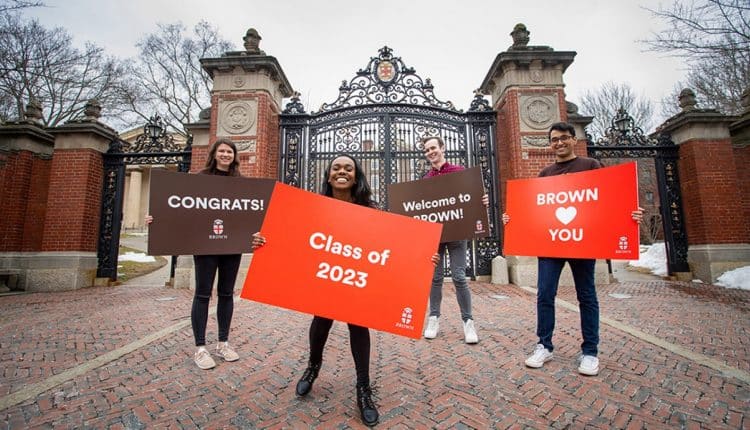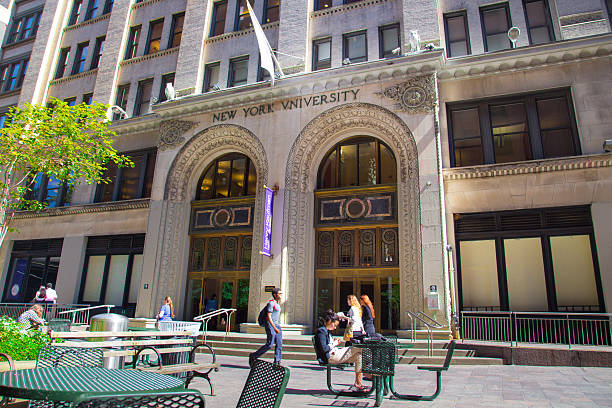Brown Acceptance Rate 2026

Brown Acceptance Rate 2026
Brown University accepted 896 students for the Class of 2026 out of 6,146 early applications received. When compared to the Class of 2025, applications through the programme increased by 11%. Brown received 5,540 applications for early decision last year and accepted 885. Brown has accepted 14.6 percent of early applicants to the Class of 2026, 16 percent to the Class of 2025, 18 percent to the Class of 2024, and 18 percent to the Class of 2023 over the last five years.
Brown University
Brown University is the seventh-oldest research higher education institution in the United States. It is a private institution founded in 1764 in Providence, Rhode Island. It is a member of the Ivy League and was the first to allow admissions without regard for religious connections. Brown University was placed 14th in the Best Colleges in National Universities 2020 edition. The institution is well-known for its outstanding English language and literature courses, economics and econometrics, and development studies.
At or within six months of graduation, 93 percent of 2018 Brown graduates went on to work or graduate/professional school. The new ‘Open Curriculum,’ introduced in 1970, permitted students to create their own core curriculum rather than being restricted to a predetermined liberal arts program. Brown University’s popular majors include economics, computer science, and biology. Through Brown’s eight-year Program in Liberal Medical Education, about 50 admitted first-year students, are accepted to the Alpert Medical School.
Brown University Campus
The magnificent campus of the institution consists of 230 buildings scattered across 150 acres. Students can follow their interests and participate in various relevant activities on campus, which has over 400 student groups. All students are expected to reside on campus for the first six semesters, with the exception of a limited number of juniors who are granted permission to live off-campus. Brown University has around 35 NCAA Division I sporting teams that play in the Ivy League.
What Is Brown University Known For?
Brown University is an Ivy League college noted for its emphasis on undergraduate education and its world-renowned open curriculum. Outside of your major, there are no general education or mandatory courses. You can select one of the ninety or so established majors, or you can entirely construct your own major and curriculum. Students here are in charge of their own fate and are not instructed what to do or take. Brown was also the first Ivy League institution to establish an engineering school, as well as the first one to offer a combined BA/MD program.
1. Brown’s flexible curriculum encourages students to pursue their passions.
The great majority of universities require students to take a list of compulsory courses during their first year of college. This is referred to as a core curriculum, and it may even stretch into sophomore year, depending on the school.
Brown’s open curriculum allows students to study the university’s numerous majors and topics by taking a variety of courses. You are not bound by any core curriculum that prescribes which classes you must take.
Even if you’ve already decided on a major, you can experiment with alternative subjects. You are in command of your college education under this arrangement. There are still certain criteria, but they are substantially less onerous than at other top-tier colleges. These prerequisites are as follows:
Brown University’s learning approach is more focused on exploration and growth than satisfying standard criteria, which many students value and prefer.
Another significant advantage of this open curriculum is the option to take a course on a pass or fail basis rather than a traditional grade system. Brown does not use GPAs like other institutions; therefore, students are not restricted to taking a certain amount of pass/fail courses. Again, by removing the emphasis from grades and obligations, students have more freedom – and less stress – to investigate other topics, subjects, and hobbies.
2. Brown has a distinct culture.
Every Ivy League university has taken on its own personality. When undertaking college visits, you may function as an anthropologist analyzing the various school cultures if you attend more than one of these eight colleges. There will be many cultures, traditions, motifs, and patterns that you will observe.
Brown University’s open curriculum has created a culture of openness, discovery, and – in a way – adventure. When it comes to educational innovation, Brown is less burdensome than other Ivy League schools, drawing a large number of like-minded students.
Brown University’s student body is made up of people who are creative, open-minded, curious, clever, and hardworking. Students that attend Brown are not your average students, even by Ivy League standards.
The great majority of kids who are admitted are at the top of their high school class, are extremely active both inside and outside of the classroom, and have BIG dreams for the future. What’s amazing about Brown University is that it provides a space for all of these smart and like-minded people to grow and develop together, both personally and academically.
Although academics are an important element of the Brown University community, the intellectual curiosity of its students goes beyond the classroom. Extracurricular activities, including clubs, intramural sports, and other on-campus but non-academic events, have a rich culture of engagement. When you visit Brown, you might be surprised by how pleasant and open the student body is.
3. The student body is quite diverse.
There’s a stereotype about college that it’s the ideal time to try new and exciting things. Even if it’s overused, there’s some truth to the remark. Few students desire to attend a college that is essentially the same as their high school.
Another excellent aspect of this institution that makes it easy to answer the question “why Brown?” is its welcoming and invigorating variety. In reality, less than 10% of the student body is from Brown’s native state of Rhode Island. The remainder of the domestic student body is drawn from different states around the country.
As a result, you have a higher probability of meeting someone from another state than you have of meeting someone from your own. This entails gaining a fresh viewpoint, confronting concepts, and countless opportunities to learn. However, Brown’s wide variety does not end there, as the university has a long tradition of drawing foreign students from all across the country.
Brown is beckoning if you want to learn about and experience various cultures without having to leave the country. Over 100 different nations are represented among the pupils. Furthermore, Brown has one of the greatest ethnic diversity rates in the country, especially among Ivy League colleges.
4. The campus is the ideal size
Granted, this is one of the more objective reasons to adore Brown, but it’s still an excellent reason to answer the question, “Why would someone select Brown University over other elite universities?” Aside from academic offerings, geography, and student population, the size of the campus is an essential factor for many students. They seek to ensure that there is plenty to accomplish without becoming overburdened. The number of students on campus is also influenced by the size of the campus, which has an impact on the learning experience.
Larger class sizes at larger schools might make it harder for certain children to pay attention and study, affecting their academic achievement. A campus that is too tiny, on the other hand, may have restricted offers as compared to a larger institution with superior finances.
Fortunately, Brown achieves the ideal balance between a small school with limited options and a huge school with an overabundance of kids. With a student body of slightly under 9,000, Brown is the appropriate size for those seeking this balance. This is evident in class numbers, which are often less than 20 students, providing a more intimate and collaborative learning environment.
5. There Are plenty of extracurricular activities and things to do outside of school.
When determining “why to go to Brown University?” or any college for that matter, students must evaluate more than just what happens in the classroom. Because you will spend the great majority of your time in college outside of the classroom, it is critical that you select an institution that provides a variety of extracurricular activities.
Fortunately, this is just a more compelling reason to go with Brown. This Ivy League university has over 300 student clubs where you may find an extracurricular activity or club for almost everything you can think of. Even if you can’t find what you’re searching for, starting your own club is simple.
Are you bored with planned or group activities? Not a problem! Brown University is a stop on the way to many interesting events. There are several concerts, seminars, films, and other entertaining and educational events. Even better, all of these events are organized and planned by students, which means you have a say in who and what comes to Brown.
While the campus of this institution is beautiful, let us not confine our attention to it. You don’t intend to spend all of your leisure time there. The nearest town, Providence, is only a few minutes away by vehicle or public transit and is bustling with activity.
Providence isn’t the largest city in the world, but that’s exactly why so many students adore it. Providence, like Brown University’s campus, finds the correct size by finding a balance between a low-key environment and enough offerings.
There are plenty of restaurants, cafés, museums, cultural centers, shopping, libraries, and other attractions without having to worry about living in a stuffy, filthy, and congested metropolis. When entering the city, be sure to bring your student ID. You never know what type of savings you’ll receive as a result of attending Brown! And as a student on a tight budget, you don’t want to miss out on them.
Brown Acceptance Rate 2026
Brown University accepted 896 students for the Class of 2026 out of 6,146 early applications received. When compared to the Class of 2025, applications through the programme increased by 11%. Brown received 5,540 applications for early decision last year and accepted 885. Brown has accepted 14.6 percent of early applicants to the Class of 2026, 16 percent to the Class of 2025, 18 percent to the Class of 2024, and 18 percent to the Class of 2023 over the last five years.
You can improve your chances and beat Brown acceptance rates with the right test scores and a knowledgeable admissions counselor from AdmissionSight at your side. Brown ranks among the top national universities. The Brown acceptance rate is similar to that of other high-ranking universities, such as Harvard and Stanford.
Candidates with the correct scores and grades have a good chance of getting a foothold at Brown. Brown, like every other Ivy League school, has a comprehensive admissions procedure. This implies you must be an all-around achiever who excels in extracurricular activities as well.
Each year, over 35,000 students apply to Brown. With 36,794 candidates, last year’s pool was the highest ever. The brown acceptance rate for the year was 6.9 percent, the lowest since 2016. There were 2,533 students admitted, with 800 of them being early decision applications. Almost 96% of selected candidates graduated in the top 10% of their high school classes.
Brown University Diversity
If you enroll at Brown University, you will be part of an intriguing and varied class. There are students from all over the world, as well as from the United States, with a balanced gender ratio. In actuality, the typical class comprises 54% female pupils and 46% male students.
Brown University has students from all over the world, with the most being from Bangladesh, Honduras, Mongolia, Switzerland, Vietnam, Slovakia, and Saudi Arabia. Students are chosen from all 50 states, with California, New York, Massachusetts, New Jersey, and Texas ranking first through fifth.
On average, 12 percent of admitted candidates are first-generation students. Brown has a sizable population of students of color.
55 percent of applicants are students of color, while 45 percent are Caucasians. Admitted candidates come from a variety of ethnic backgrounds. Asian Americans make up the majority (20%), with Hispanics/Latinos coming in second at 11%. African Americans make up 9% of the population, while Native Americans make up 2%.
Courses At Brown
What are the most popular courses in the university? Brown University is well-known for its observable undergraduate experience, which is rooted in its flexibility but meticulous open curriculum. The campus is home to several schools, the most prestigious of which is the Warren Alpert Medical School. It provides a diverse range of pre-college, master’s, and doctoral programs.
Students can choose from 79 majors and study a variety of subjects at the university. Engineering, computer science, political science, economics, biology, biochemistry and molecular biology, international and public affairs, English, neuroscience, and applied math are among the top ten intended majors.
Brown University SAT Scores
What is the average SAT/ACT score of those admitted? At 6.9 percent, the brown acceptance rate is among the lowest in the country. This means that only 7 students are accepted for every 100 applications.
To say that the admissions committee is selective would be an understatement. This makes it critical that you meet their SAT/ACT and GPA requirements in order for your application to be considered.
If you want to pass their first round of filters, you must have the appropriate test scores and grades. To gain admission to a prestigious university such as Brown, you must also demonstrate your academic preparation. If you don’t meet their expectations, your chances of getting into college are slim.
Brown University does not need an SAT essay. It even waives the need for the candidate to take SAT subject examinations. However, it is advised that applicants take the SAT essay and two SAT topic examinations to help them stand out. Brown adheres to the SAT superscore policy. This indicates it accepts the College Board’s Score Choice and will select the highest SAT score if you took the test more than once.
Brown also accepts ACT scores. According to National ACT statistics, chosen Brown applicants made up the top 4% of test-takers. However, SAT/ACT scores are not the only factor considered by the university. To be eligible for a Brown education, you must also have the appropriate high school grades.
Almost all of the applicants chosen are in the top 10% of their graduating class. The majority of pupils received all of their grades in the “A” category. A minimum of 4.0 GPA is required to make an impression on the admissions committee, and the acceptance rate at Brown is relatively low. Extracurricular activities, coursework difficulties, personal statements, and letters of reference are all considered in the final admissions decision.
Brown University Admissions
Brown University is a prestigious private university with a strict admissions policy. The university is a medium-sized institution in Providence, Rhode Island. It has a total of 6,766 undergraduate students enrolled.
The acceptance rate for brown is only 6.9 percent. You must ensure that your application and any supporting papers are free of errors. Many qualified individuals have their complete applications rejected due to minor mistakes.
Brown University, like any other institution, demands an application that includes the minimal necessities, such as GPA and school record, SAT scores, letters of recommendation, interviews, essays, and other vital information. To begin the process, you must submit the Common Application online.
Brown University allows candidates to participate in an optional interview. If you are lagging behind on your exam results, this might be a wise strategy to highlight your unique qualities and other accomplishments.
Brown offers an excellent online approach for completing the Common Application. It will walk you through the process of submitting all required supporting documents for first-year candidates.
Brown University Tuition

Brown University’s yearly tuition is $77,490. This amount, however, includes the total cost of attendance for both the spring and autumn semesters. The amount includes everything from tuition and books to housing and board, with a little amount left aside for personal costs.
Brown takes pride in providing significant financial aid packages that are debt-free. This suggests that the ordinary student would have to pay significantly less to get an education at this school. The institution promises that every year, every student’s need is addressed.
Financial aid is one of Brown’s strongest strengths and top goals. The institution pledges to give every student an equal opportunity to study here.
Brown University regularly recruits students from a wide range of social and financial backgrounds. They have a need-blind approach to admissions, which implies that the applicant’s capacity or unwillingness to pay the cost of attendance or tuition has no bearing on the admission decision. In reality, 62% of applicants chosen through the Early Admissions pool had sought financial help.
Brown University is well-known for satisfying all of its students’ documented financial needs. The Brown Promise Initiative has enabled bundled loans to be totally removed from undergraduate financial aid disbursements. This implies that the significant financial help provided by the institution is debt-free.
The college is dedicated to ensuring that no outstanding student is denied an Ivy League education due to financial constraints. However, the university encourages all students to look into additional kinds of financial assistance, such as scholarships from governmental and private organizations.
It is crucial to note that private scholarships will not be used to reduce the amount of financial assistance from Brown unless the funds surpass the percentage of your package represented by summer earnings and work-study.
For families with an annual income of $60,000 or less, the parent contribution is $0 on average. Furthermore, all graduating Brown University students who receive student financial help are debt-free. You can use Brown University’s Quick College Cost Estimator to evaluate your college costs and determine your eligibility for need-based scholarships.
Brown Early Decision
If Brown is your top college option, you should consider applying under the Early Decision method. You should be aware, however, that if you are accepted to Brown University, you will be obliged to withdraw all other applications, whether normal, early, or rolling.
You can also apply through the Regular Decision process. Most first-year students prefer Regular Decision because it allows them adequate time to finish their application and highlight more noteworthy achievements in their application essay.
Early Action candidates often receive their decisions by mid-December. Applicants for Regular Decision are generally notified of their decision by the end of March. In this instance, admitted students are asked to respond by May 1st. All accepted students who desire to enroll at Brown University must submit official exam results by June 1st.
Brown Transfer Acceptance Rate
Brown admits 7.7 percent of transfer candidates, making it competitive. To be considered for transfer to Brown, you must have a current GPA of at least 4.0 – ideally, your GPA will be around 4.16. You will also be required to provide standardized test results.
Brown Early Decision Acceptance Rate
Brown University accepted 896 applicants for the class of 2026 out of 6,146 early applications received. When compared to the Class of 2025, applications via the program increased by 11%. Brown received 5,540 applications for early decision last year and accepted 885. Brown has admitted 14.6 percent of the class of 2026, 16 percent of the class of 2025, 18 percent of the class of 2024, and 18 percent of early applications to the class of 2026 in the last five years.
Brown Medical School Acceptance Rate 2026
Brown Medical School is one of Rhode Island’s nine medical schools. Warren Alpert Medical School at Brown University, being an Ivy League medical school, is often regarded as the most prestigious and well-known in the world.
The total acceptance rate at Brown University’s Warren Alpert Medical School is 2.13 percent, with in-state candidates accounting for 10.42 percent, out-of-state applicants accounting for 88.89 percent, and overseas applicants accounting for 0.70 percent.
Brown Graduate School Acceptance Rate 2026
Brown, being an Ivy League institution, receives thousands of applications each year but admits less than 10% of those students. Its graduate program acceptance rates are significantly lower. Brown was placed in the top 10 of all American universities by Forbes, and it was also listed in the top 20 by U.S. News and World Survey and in the top 50 by the ARWU report. ARWU, Times, and QS all classified Brown as one of the top 100 institutions in the world, based on class size, student possibilities, faculty experience, and other considerations. It also garnered national attention for its medical school, engineering programs, business programs, and MFA writing programs.
Brown University Notable Alumni

Brown University’s notable alumni include the Chief Justice of the United States Supreme Court, 8 billionaire graduates, 4 U.S. State Secretaries and other Cabinet officials, 56 Rhodes Scholars, 54 members of the United States Congress, 52 Gates Cambridge Scholars, 14 MacArthur Fellows, 21 Pulitzer Prize winners, 49 Marshall Scholars, and several others. Ten National Medal of Science laureates and five National Humanities Medalists are among the institution’s staff and graduates, as are eight Nobel Prize winners who are affiliated with the university. Brown University has produced a number of noteworthy alumni, including:
- John Fitzgerald Kennedy Jr., sometimes known as JFK Jr. or John-F.Kennedy is the sole surviving son of U.S. President John F. Kennedy and First Lady Jacqueline Bouvier Kennedy, as well as Caroline Kennedy’s younger brother. John worked as a writer, magazine publisher, and attorney in the United States. Kennedy graduated from Brown University with a bachelor’s degree in American studies in 1983 and then took a hiatus, traveling to India and spending time at the University of Delhi, where he met Mother Teresa. While at Brown University, Kennedy performed in a number of plays. In 1995, Kennedy and Michael Berman co-founded George, a glossy, politics-as-lifestyle and fashion monthly, with the former Kennedy owning 50% of the stock.
- John Krasinski – Krasinski studied English at Brown University and graduated in 2001 as a dramatist with the honors thesis ‘Contents Under Pressure.’ Krasinski, an American actor and director was a member of the sketch comedy group Out of Bounds at Brown University. Krasinski is best known for his role as Jim Halpert on the NBC sitcom The Office, for which he also acted as a producer and sometimes director for the entire nine-season run. Krasinski, who studied theatrical arts at Brown University, has received a variety of honors, including two Screen Actors Guild Awards and four Primetime Emmy Award nominations. He was also named one of the 100 most important persons in the world by the Times in 2018.
- Emma Watson: Emma Watson is an actress. Emma Charlotte Duerre Watson, an English actor and model was born in Paris and raised in Oxfordshire. Watson graduated from Brown University in May 2014 with a bachelor’s degree in English literature and was named British Artist of the Year by the British Academy of Film and Television Arts the same year. Watson, a UN Women Goodwill Ambassador, was essential in the establishment of the UN Women initiative HeForShe, which encourages men to fight for gender equality. Watson rose to notoriety as Hermione Granger in all eight Harry Potter films from 2001 to 2011, gaining international renown, critical acclaim, and over $60 million.
- Bobby Jindal – Bobby Jindal was the 55th Governor of Louisiana, is an American politician who graduated from Brown University in 1992 at the age of 20 with honors in two majors, biology and public policy. Jindal was named secretary of the Louisiana Department of Health and Hospitals in 1996, and in 1999, at the age of 28, he became the University of Louisiana System’s youngest president. Jindal was appointed as the main adviser to the United States Secretary of Health and Human Services by President George W. Bush in 2001.
Brown University Ranking
- #14 in National Universities (tie)
- #3 in Best Colleges for Veterans
- #4 in Best Undergraduate Teaching
- #19 in Best Value Schools
- #29 in Most Innovative Schools (tie)
- #169 in Top Performers on Social Mobility (tie)
- #36 in Best Undergraduate Engineering Programs (tie)
- #1 in Writing in the Disciplines
- #27 in Undergraduate Research/Creative Projects (tie)
- #14 in Service Learning (tie)
- #13 in First-Year Experiences (tie)
- #5 in Senior Capstone
Brown University Population
What is the student body at Brown University like? Although it varies from year to year, the student population of Brown University is normally around 9,000, classifying it as a medium-sized institution. Brown students are noted for their academic curiosity, open-mindedness, and innovation.






whoah this blog is wonderful i really like reading your articles. Keep up the great paintings! You realize, a lot of people are hunting round for this info, you could help them greatly.